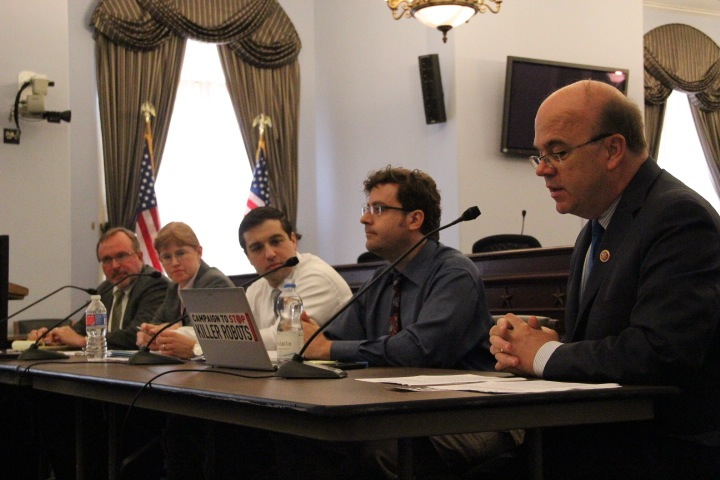
Congressional briefing on killer robots

On Tuesday, 15 July, Representative Jim McGovern (D-Mass.) convened a “special briefing on killer robots” to discuss issues surrounding the development and use of fully autonomous lethal weapons. Roughly 65 people attended the briefing held in the Cannon House Office Building of the US Capitol from various Congressional offices as well as from the State Department and Department of Defense, including Defense Advanced Research Projects Agency (DARPA). The panel that provided the briefing featured the author of the 2012 Department of Defense policy on autonomous weapons and three experts from the Campaign to Stop Killer Robots.
In his opening remarks, Rep. McGovern clarified that he became aware of the killer robots challenge “not because of its catchy name, but as Congress was wrestling with the moral and legal questions surrounding the use of drones to kill human beings abroad.” He clarified that the purpose of the briefing was not to talk about weaponized drones that “in their current form and use have what we call ‘a man in the loop.'” Rather, the briefing aimed to look what happens when the “human element” is removed by focusing on weapons “that would be able to select and attack targets on their own – in essence, lethal machines that would be able to target and kill people without human intervention.”
Each panelists spoke briefly before Rep. McGovern opened the floor for questions:
- Dr. Peter Asaro, vice-chair of the International Committee for Robot Arms Control came from New York for the briefing, where he directs Graduate Programs for the School of Media Studies at the New School for Public Engagement. Asaro described how current military technology has automated some operations, such as navigation and flight, but the decision to identify a target and execute a strike still remains with the human operator. The objective of the Campaign to Stop Killer Robots, which ICRAC co-founded, is to prevent the creation of technology that would have the ability to find its target and exercise lethal force without human intervention. One way to do that is to focus on how to ensure meaningful human control of decisions to target and use force.
- Mr. Paul Scharre is a project director of the 20YY Warfare Initiative at the Center for a New American Security in Washington DC and worked in 2008-2013 for the Office of the US Secretary of Defense, where he played a leading role in the creation of the first Department of Defense policy on autonomous weapons. Prior to that, Mr. Scharre served in the US Army and completed multiple tours in Iraq and Afghanistan. Scharre gave a brief introduction to the history of autonomous weaponry in warfare and noted various different types of semi-autonomous weapons currently in use by militaries across the globe, including the US Patriot and Aegis systems and Israel’s Iron Dome. While at present no nation has expressed clear intent to develop fully autonomous weapons, including the US, drivers toward autonomy include the need for swifter reaction time beyond human capabilities as well as the ability to continue operations if communications links are severed. Scharre said that Directive 3000.09 on Autonomy in Weapon Systems outlines existing best practices with current technology and suggested an international non-binding code of conduct would serve to limit the negative effects of autonomous weapons.
- Ms. Bonnie Docherty is a lecturer on law and the senior clinical instructor at the International Human Rights Clinic at Harvard Law School. She is also a senior researcher in the arms division at Human Rights Watch and author of the 2012 Losing Humanity report on international humanitarian law concerns with fully autonomous weapons and the 2014 Shaking the Foundations report by both organizations on the human rights law implications of these weapons. Ms. Docherty described why existing international law is seen as inadequate when it comes to addressing use as well as the development, production, and proliferation of fully autonomous weapons. She described the arbitrary denial to the right to life that would occur from the use of these weapons and said there is doubt that they’d meet the three cumulative criteria necessary to carry out lawful killings, as they require qualities that robots are unlikely to possess.
- Mr. Steve Goose directs the arms division at Human Rights Watch in Washington DC, and before joining in 1993 worked as a staff member of the House Appropriations Committee. Mr. Goose introduced the Campaign to Stop Killer Robots launched in April 2013 and described the expressions of support made over the past year by roboticists and scientists, UN officials, the International Committee of the Red Cross, Nobel Peace laureates, and others. Now governments have started to address the matter with the first multilateral meeting by the Convention on Conventional Weapons in May 2014. Mr. Goose described the rationale for a preemptive ban on fully autonomous weapons and how one could be achieved through a new international instrument as well as national law.
There were several questions covering a range of concerns including the viability of an international treaty, status of research and development by the US, concept of meaningful human control, and views of the scientific community on the need for regulation. Rep. McGovern concluded the event by noting that “it’s not far-fetched to think about lethal autonomous weapons systems now” in order to consider consequences of this technology and what can be done.
The briefing is believed to be the first on the Hill on the topic (by civil society representatives, in any case), but it does not mark the first initiative on killer robots by an elected representative.
Earlier this year the Hawaii state legislature considered a resolution calling for a moratorium on lethal autonomous robots.
On 27 February 2014, Hawaii state Representative Angus McKelvey introduced a draft resolution urging the US government to “place a moratorium on the development, production, deployment, and use of lethal autonomous robotics” and “encourage other nations to do the same until an internationally agreed upon framework on the future of autonomous robotics has been established.” The Hawaiian legislature’s Committee on Veterans, Military, & International Affairs, & Culture and the Arts voted to pass the measure on the resolution on 2 April. The House adopted HD 1 the next day then the Senate received the resolution and referred it to committee for further consideration. Representative McKelvey intends to re-introduce the draft resolution in the next legislative session, starting in January 2015.
Rep. McKelvey told the campaign that he drafted the resolution after reading the 2013 scientists’ call to action by ICRAC and the report by a UN special rapporteur Christof Heyns on lethal autonomous robototics, which urged all nations to enact moratoria on the weapons.
The briefing was covered by media, including Roll Call and the National Journal.
For more information, please see:
- Photographs from the event
- Alex Brown, “One Congressman’s Crusade to Save the World From Killer Robots,” National Journal, 17 July 2014
- Paul Scharre, “Killer robots and human control in the use of force” – Part I & Part II on the Just Security blog, 17 July 2014
Photo: Special briefing on “Killer Robots” (c) Manon Barthod for the Campaign to Stop Killer Robots, 15 July 2014


